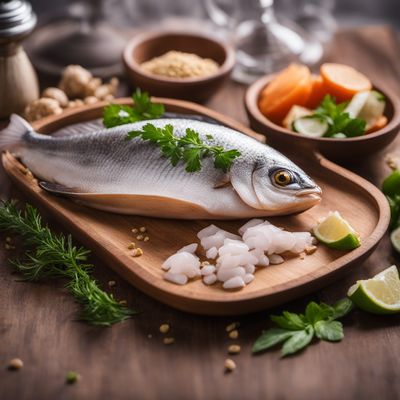
Ingredient
Shads
The Delicate Delight
Shads are small, silvery fish with a soft texture and a rich, oily flavor. They have a delicate, almost buttery taste that pairs well with citrus and fresh herbs. The flesh is tender and flakes easily, making it ideal for grilling, baking, or smoking. Shads are often enjoyed whole, including the bones, which add a unique crunch and depth of flavor to dishes.
Origins and history
Shads have a long history of culinary use, particularly in European and North American cuisines. They are native to the Atlantic Ocean and are commonly found along the coasts of Europe and North America. Shads have been a popular food source for centuries, with references to their consumption dating back to ancient times. They are often associated with traditional springtime celebrations, such as the Shad Festival in Lambertville, New Jersey.
Nutritional information
Shads are a good source of omega-3 fatty acids, which are beneficial for heart health. They also provide protein, vitamin D, and various minerals. A 3-ounce serving of shads contains approximately 150 calories.
Allergens
Shads may contain allergens such as fish proteins, which can cause allergic reactions in some individuals.
How to select
When selecting shads, look for fish that have clear, bright eyes, shiny skin, and a fresh, oceanic smell. The flesh should be firm and spring back when pressed. Avoid fish with dull eyes, discolored skin, or a strong fishy odor.
Storage recommendations
To maintain the freshness of shads, store them in the refrigerator at a temperature of 32°F to 38°F (0°C to 3°C). Keep them wrapped in plastic or place them in an airtight container to prevent odor transfer. Use them within 1 to 2 days of purchase for the best quality and flavor.
How to produce
Shads are typically caught in the wild, but they can also be farmed in some regions. To produce shads, a suitable habitat with access to clean, flowing water is required. The fish are usually raised in large tanks or ponds and fed a diet of small fish and crustaceans.
Preparation tips
Shads can be prepared in various ways, including grilling, baking, smoking, or pan-frying. They are often marinated or seasoned with herbs and spices to enhance their natural flavors. Shads can be enjoyed whole, including the bones, or filleted for a boneless option. They pair well with citrus fruits, fresh herbs, and light sauces. When grilling or baking shads, be careful not to overcook them, as they can become dry.
Culinary uses
Shads are commonly used in dishes such as grilled shad with lemon and herbs, smoked shad dip, or shad roe sautéed in butter. They are also a popular ingredient in traditional British dishes like shad pie or shad roe on toast. In North America, shads are often celebrated during the spring season with festivals and events dedicated to their culinary significance.
Availability
Shads are commonly available in coastal regions of Europe and North America, particularly during the spring season when they migrate upstream to spawn. They can also be found in some specialty seafood markets or ordered online for delivery.
